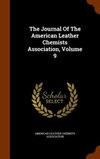Interaction between Amphoteric Polymer and Silicic Acid Tanned Leather
IF 0.5
4区 工程技术
Q4 CHEMISTRY, APPLIED
Journal of The American Leather Chemists Association
Pub Date : 2023-10-02
DOI:10.34314/jalca.v118i10.8229
引用次数: 0
Abstract
Silicic acid-based tanning system is an effective and promising chrome-free tanning technology, and it is urgent to develop compatible post-tanning processes. Fatliquoring is one of the key procedures to determine the quality of resulted leather and fatliquoring agents mainly play the role of an effective softer/ plasticizer in leather production. However, there is a mismatch between most commercial fatliquoring agents (mainly compatible with chrome tanned leather) and silicic acid tanned leather (named SATL). Herein, an amphoteric polymer emulsion (APE) was prepared by free radical polymerization using methacryloxyethyl trimethyl ammonium chloride (DMC), 2-acrylamido-2-methylpropanesulfonate (AMPS), lauryl methacrylate (LMA), dimethylaminoethyl methacrylate (DMAEMA) as monomers. And in order to improve the lubricating property, APE was further compounded with castor oil to obtain an amphoteric fatliquoring agent (named COAPE). Comprehensive characterization showed that the amphoteric (pI=8.22) and amphiphilic APE could reduce the surface tension of water to 38.6 mN/m. The fatliquoring process was controlled by ingenious regulation of pH based on isoelectric points (pIs) of APE and SATL. In the initial stage, the pH of the bath was adjusted to be lower than the pIs of APE and SATL, amphoteric polymer molecules could easily penetrate into SATL leather as they are all positively charged. While during the fixing stage, the pH of the bath was adjusted between the pIs of APE and SATL, so the electrostatic interaction between amphoteric polymer molecules and SATL leather, as well as the aggregation of amphoteric polymers can promote their combination synergistically. As a fatliquoring agent, the application of COAPE demonstrated that its absorpotion rate (90.5%) was much higher than anionic commercial fatliquoring agent (63.2%), thus imparting SATL leather better softness (6.5 mm), elongation at break (95.5%) and tensile strength (11.6 N/mm2). These findings therefore provided scientific basis and technical support for the application of amphoteric materials to silicic acid-modified collagen matrix and would promote the practical application of silicic acid-based chrome-free tanning technology两性聚合物与硅酸鞣革之间的相互作用
硅酸基鞣制体系是一种有效且前景广阔的无铬鞣制技术,因此开发兼容的鞣后工艺迫在眉睫。加脂是决定成品革质量的关键工序之一,加脂剂在皮革生产中主要起着有效的软化剂/增塑剂的作用。然而,大多数商用加脂剂(主要与铬鞣革兼容)与硅酸鞣革(名为 SATL)之间存在不匹配。本文以甲基丙烯酰氧乙基三甲基氯化铵(DMC)、2-丙烯酰胺基-2-甲基丙磺酸盐(AMPS)、甲基丙烯酸月桂酯(LMA)和甲基丙烯酸二甲胺基乙酯(DMAEMA)为单体,通过自由基聚合制备了两性聚合物乳液(APE)。为了改善润滑性能,APE 进一步与蓖麻油复合,得到了两性加脂剂(命名为 COAPE)。综合表征结果表明,两性(pI=8.22)和两亲性 APE 可将水的表面张力降至 38.6 mN/m。根据 APE 和 SATL 的等电点(pIs),通过巧妙调节 pH 值来控制加脂过程。在初始阶段,浴液的 pH 值被调节到低于 APE 和 SATL 的等电点,两性聚合物分子很容易渗透到 SATL 皮革中,因为它们都带正电。而在固色阶段,浴液的 pH 值调节在 APE 和 SATL 的 pI 之间,两性聚合物分子和 SATL 皮革之间的静电作用以及两性聚合物的聚集可促进它们协同结合。作为加脂剂,COAPE 的吸收率(90.5%)远高于阴离子商业加脂剂(63.2%),从而赋予 SATL 皮革更好的柔软度(6.5 毫米)、断裂伸长率(95.5%)和拉伸强度(11.6 牛/平方毫米)。因此,这些研究结果为两性材料在硅酸改性胶原基质中的应用提供了科学依据和技术支持,并将促进基于硅酸的无铬鞣制技术的实际应用。
本文章由计算机程序翻译,如有差异,请以英文原文为准。
求助全文
约1分钟内获得全文
求助全文
来源期刊

Journal of The American Leather Chemists Association
工程技术-材料科学:纺织
CiteScore
1.30
自引率
33.30%
发文量
29
审稿时长
3 months
期刊介绍:
The Journal of the American Leather Chemists Association publishes manuscripts on all aspects of leather science, engineering, technology, and economics, and will consider related subjects that address concerns of the industry. Examples: hide/skin quality or utilization, leather production methods/equipment, tanning materials/leather chemicals, new and improved leathers, collagen studies, leather by-products, impacts of changes in leather products industries, process efficiency, sustainability, regulatory, safety, environmental, tannery waste management and industry economics.
 求助内容:
求助内容: 应助结果提醒方式:
应助结果提醒方式:


